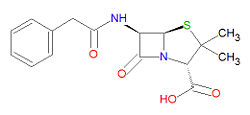Penicillin G
|
| |||||||
| penicillin G | |||||||
| |||||||
| Uses: | antibiotic drug | ||||||
| Properties: | beta-lactam | ||||||
| Hazards: | see drug interactions | ||||||
| |||||||
Penicillin G, also called benzopenicillin or benzylpenicillin, a penicillin derivative, is a beta-lactam-based antibiotic drug used to treat severe infections from most Gram-positive and some Gram-negative cocci. It is also an experimental drug for the treatment of convulsions due to it effects on synaptic transmission mediated by gamma-aminobutyric acid.
Chemistry
Penicillin G is stable against degradation (hydrolysis) by beta-lactamases, includingpenicillinases, and cephalosporinases. Its IUPAC chemical name is (2S,5R,6R)-3,3-dimethyl-7-oxo-6-[(2-phenylacetyl)amino]-4-thia-1-azabicyclo[3.2.0] heptane-2-carboxylic acid and it has chemical formula C16H18N2O4S (MW = 334.3901 g/mol).
Mechanism of action
Penicillins work by binding to specific penicillin-binding proteins (PBPs) in the bacterial cell wall and inhibiting the final stage of bacterial cell wall synthesis, resulting in autolysis of the bacterial cells by autolysin enzymes.
Drug interactions
Penicillins increase the effects of anticoagulant drugs including acenocoumarol, anisindione, dicumarol and warfarin and lessen the effects of some oral contraceptives including ethinyl estradiol and mestranol. Tetracycline and its derivatives doxycycline, demeclocycline, methacycline, minocycline, oxytetracycline, and rolitetracycline may decrease the effectiveness of penicillin. The effects and toxicity of methotrexate increases when used with penicillins.
Brand names
|
|
|
External links
- Penicillin G - FDA approved drug information (drug label) from DailyMed (U.S. National Library of Medicine).
- Drug Bank [1]
